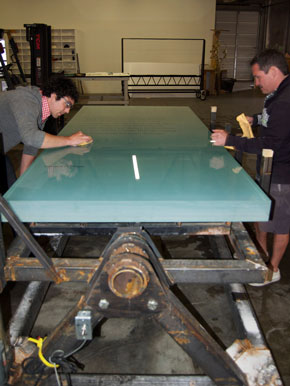One of the most challenging aspects of the Memorial was the preparation of the 48 laminated glass panels that display the soldiers’ stories through quotations and photographs. These etched glass panels form the heart of this living monument.
”Glass is a material of disclosure and transparency,” said Jerome Cloud, principal in charge of design for Cloud Gehshan Associates in Philadelphia. “It liberates and illuminates the imagery and veterans’ voices in a way that carving them into stone would not have done.”
The Memorial’s lead designer and landscape architect, Michael Vergason, specified the use of oversize glass panels for the three interpretive walls at the site, providing a suitable monumental artistic effect. Seattle, WA-based Hartung Glass Industries, a veteran-owned company, cut, polished, and tempered each glass sheet of a ¾” thick, ultra-clear glass known as Starphire Glass by PPG, which is used in the Apache helicopter and B-2 bomber. Each individual layer is 48×106 inches and weighs 360 pounds.
As a result of laminating, the Memorial’s panels are strong enough to withstand hurricane-force winds without bending, breaking or leaning. With five layers of glass, plus four layers of lamination, the total weight of each glass panel is approximately 1,800 pounds.
The Memorial’s Panels
Once the creative design was completed, Moon Shadow Glass, Inc., located in Sandy, Oregon, handled the etching process. “We had to produce detailed stencils and film from the original artwork,” said Tim Frasier, founder and owner of Moon Shadow Glass. “After putting those images on the glass, we manually sandblasted the surface to achieve just the right effect.”
Some of the etchings appear on the outside surfaces of the panels, allowing visitors to touch and feel the indentations, which are 1/16-inch deep. “The majority of the etching is on the interior side, where the words and images aren’t exposed to the elements,” said Kris Iverson, Moon Shadow’s marketing and creative director. “The interior etching also provides a subtle sense of depth for the artwork.”
Because the etching process results in clear images, some of the words and images have been hand painted for greater clarity and a touch of color. “The process of making the photo etchings was very challenging,” added Frasier. “We used special films to reproduce the shading of black and white photographs and captured those incredible images on glass.”
The individual etched sheets of glass were then delivered to Rich Lamothe and his team of artisans at Glass Strategies in Portland, Oregon to be sand-sealed, a process where specially formulated paint is applied by hand to an etched surface.
Using overhead and wheeled cranes, the massive sheets were placed on custom tilt-tables for lamination. Laminating the separate sheets of glass to create a panel was done by hand using a liquid resin called Polylam, manufactured by Glasslam, to fill the irregular etched spaces between the sheets of glass before hardening into a solid, unbreakable bond. Extraordinary care was required to eliminate any visible bubbles and debris specs while the Polylam was curing.
“The scope and complexity of the panels, combined with the size and weight, provided unique challenges throughout the process” said Lamothe. “We are truly honored to have been a part of this incredible testament to those who made such enormous sacrifices in service to America.”
Once the lamination was completed, a computer-controlled waterjet was used to trim each panel to its finished size. That required a careful placement of each panel into a holding device to ensure that the edges were precisely aligned vertically and horizontally. After the trimming was completed, the edges of the glass panels were rounded and polished to ensure a smooth finish that visitors can easily touch.
At the start of the design process, visionary artist Larry Kirkland created four silhouette designs for the bronze sculptures and selected the most appropriate accompanying photographs. Research firm History Associates identified a wide variety of disabled veterans’ stories and carefully selected the most suitable quotations for inscription in the Memorial.
The artwork is illuminated by light passing through the bronze cut-outs and lit up at night, animating and bringing the glass panels to life, said Cloud. “We wanted to create an interaction and a dialogue between all the elements. For example, one of the cut-out silhouettes is an image of a soldier with a crutch who appears to be standing in front of an image of Arlington Cemetery, but it is actually a projection from behind. The juxtaposition of images is a powerful and moving reminder of loss and sacrifice.”
As Frasier said, “This is a very special project for us as well as the entire nation. Most monuments are designed to honor those who have passed away, while this will be a memorial to the living. We salute these brave men and women who have made great sacrifices for the sake of our country.”

As a result of laminating, the Memorial’s panels are strong enough to withstand hurricane-force winds without bending, breaking or leaning. With five layers of glass, plus four layers of lamination, the total weight of each glass panel is approximately 1,800 pounds.
